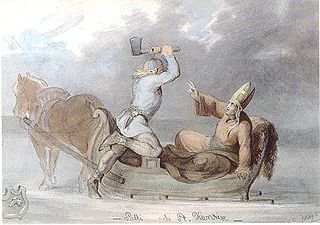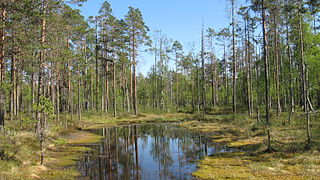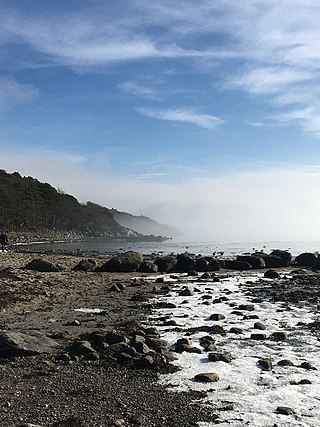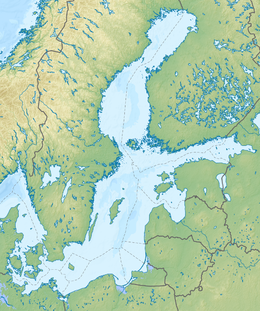
Western Finland was a province of Finland from 1997 to 2009. It bordered the provinces of Oulu, Eastern Finland and Southern Finland. It also bordered the Gulf of Bothnia towards Åland. Tampere was the largest city of the province.

Lalli is an apocryphal character from Finnish history. According to the legend, he killed Bishop Henry on the ice of Köyliönjärvi on 20 January 1156.

Houtskär is an island group and former municipality of Finland. On 1 January 2009, it was consolidated with Iniö, Korpo, Nagu and Pargas to form the municipality of Pargas.

Ostrobothnia is a region in western Finland. It borders the regions of Central Ostrobothnia, South Ostrobothnia, and Satakunta. It is one of four regions considered modern-day Ostrobothnia, hence it is also referred to as Coastal Ostrobothnia to avoid confusion.

Masku is a municipality of Finland. It is located in the province of Western Finland and is part of the Southwest Finland region. The municipality, which is located about 17 kilometres (11 mi) just north of Turku, has a population of 9,616 (31 December 2023) and covers an area of 204.01 square kilometres (78.77 sq mi) of which 29.21 km2 (11.28 sq mi) is water. The population density is 54.98 inhabitants per square kilometre (142.4/sq mi).

Naantali is a town in Southwest Finland, and, as a resort town during the summer, an important centre of tourism in the country. The municipality has a population of 19,993 (31 December 2023), and is located 14 kilometres (8.7 mi) west of Turku.

Nagu is a former municipality and parish of Finland. On 1 January 2009, it was consolidated with Houtskär, Iniö, Korpo and Pargas to form the new town of Väståboland. On 1 January 2012 the name Väståboland was changed to Pargas.

The Archipelago Sea is a part of the Baltic Sea between the Gulf of Bothnia, the Gulf of Finland and the Sea of Åland, within Finnish territorial waters. By some definitions it contains the largest archipelago in the world by the number of islands, although many of the islands are very small and tightly clustered.

Själö or Nagu Själö or Seili is a small island, off the main islands of Nagu, in the Archipelago Sea, off the south west coast of Finland. Själö is part of the municipality of Pargas. The island is known for its church and nature, a research institute and a former hospital.

Åboland is a sub-region in the archipelago of the Southwest Finland region in south-western Finland.

Utö is a small island in the Archipelago Sea in the Baltic sea and belongs to Finland's Pargas municipality. It is the southernmost year-round inhabited island in Finland. Utö has an area of 0.81 square kilometres and the population was c. 40.

Lauhanvuori National Park is a national park in the Southern Ostrobothnia region of Finland, on the border of Kauhajoki and Isojoki. It was established in 1982 and covers 53 square kilometres (20 sq mi).

Archipelago National Park is a national park in Southwest Finland. It was established in 1983 and includes 500 km2 (190 sq mi) of land area. Most of the land is on islands smaller than 1 km2 (0.39 sq mi). The park encompasses about 2,000 of the 8,400 islets and skerries within the cooperative area. The larger islands are mainly owned by their inhabitants. Archipelago National Park is part of the UNESCO biosphere reserves and received a PAN Parks certificate in 2007.

The Åland archipelago consists of several thousands of islands, skerries and desolate rocks. About 60-80 islands are inhabited. In the east, the archipelago is connected to Turku archipelago — the archipelago adjacent to the southwest coast of Finland.

Pargas is a town and municipality of Finland, in the Archipelago Sea, the biggest archipelago in the world by the number of islands, 50,000. The big limestone mine in Pargas is the base of the main industry and except for the central parts, the municipality is still mostly rural.

Rikkavesi is a medium-sized lake in eastern Finland. At approximately 63 square kilometres, it is the 66th largest lake in Finland. Rikkavesi is situated in the municipalities of Kaavi, Outokumpu and Tuusniemi.

Seili is the second studio album by Finnish pop singer Jenni Vartiainen. It was released by Warner Music Finland digitally on 31 March 2010, with the official physical release following on 14 April. From 31 March to the official physical release date, the album was sold at €19 in conjunction with Ilta-Sanomat. The album was re-released on 14 January 2011, in a limited vinyl edition. The Finnish-language album, incorporating electro and synthpop elements along with melancholic piano ballads, is named after the island Seili, located off the south-west coast of Finland. The album was produced and co-written by Jukka Immonen with Vartiainen writing also two of the songs. The main lyricists were Teemu Brunila and Mariska who contributed to the thematical dualism of the album—Brunila wrote the happier songs about publicity and finding love while Mariska wrote the lyrics for the songs that deal with darker and more serious themes, such as death. Another lyricist was Paula Vesala. Vartiainen participated more in the production than with her debut album Ihmisten edessä, by playing for example piano and kantele.

The Invasion of Åland was a 1918 military campaign of World War I in Åland, Finland. The islands, still hosting Soviet Russian troops, were first invaded by Sweden in late February and then by the German Empire in early March. The conflict was also related to the Finnish Civil War including minor fighting between the Finnish Whites and the Finnish Reds.





















